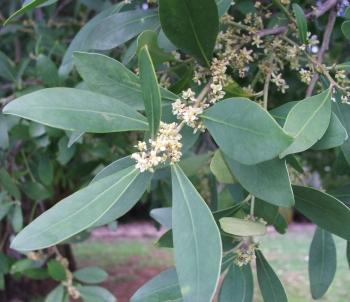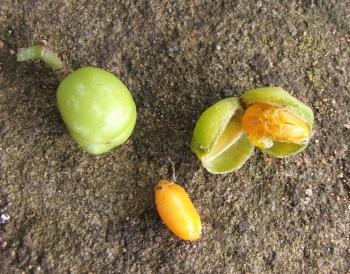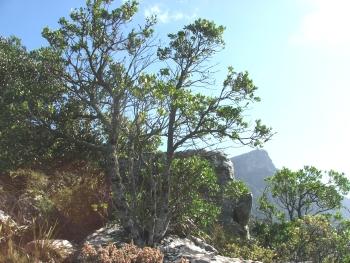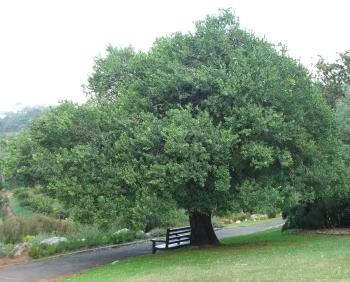Maytenus oleoides
Maytenus oleoides (Lam.) Loes.
Family: Celastraceae
Common names: mountain maytenus ( Eng. ); klipkershout (Afr.)
SA Tree No: 400
Introduction
Maytenus oleioides is a handsome tree with a deep green, dense, rounded crown and stout trunk, a good choice for today's smaller gardens as it develops the proportions of a massive tree yet does not get much taller than 4 or 5 m.

Description
Description
Maytenus oleoides is a shrub or small stocky tree about 4-6 m high. The bark is pale greyish brown to ashen grey, smooth when young, becoming rough and corky with vertical grooves as it matures. The light grey bark contrasts with the deep green crown.

The leaves are hard and leathery, bright green with a bluish bloom. They are simple, alternate and egg-shaped to oval with a narrowed base, the midrib is ridged above, the margins are untoothed and rolled back and the apex is rounded, sometimes notched. When snapped and the two sections pulled apart, they do not have drawn out silken threads characteristic of some species e.g. M. acuminata. It has a characteristic pale green sap-but this is not a very obvious feature in that it does not ooze sap freely. Young growth is coppery red and the petioles and new stems are often a decorative pinkish red.

The flowers are small, creamy white, in tight clusters in the axils of the leaves, mainly during spring (Aug.-Nov.), although the Kirstenbosch garden specimens were in full flower in early winter (May-June). The fruit is a 2-lobed capsule about 10 mm in diameter, fleshy at first, greenish yellow, becoming yellow-orange and dry when mature, splitting in summer (Dec.) to release seeds that are covered by a yellow aril.

Maytenus oleoides and Pterocelastrus tricuspidatus (cherrywood/ kershout ) are often confused for each other. Both have thick leathery leaves of similar colour, size and shape, both with rolled back, entire margins, and whitish cream flowers in axillary clusters. But they can be distinguished quite easily when you know what to look for:
- Pterocelastrus has distinctly 4-angled stems where those of Maytenus oleoides are rounded.
- Pterocelastrus has a wedge-shaped midrib that peters out well before the apex.
- Pterocelastrus has 3-lobed fruits and each lobe has 1 or 2 wing-like horns, those of Maytenus oleoides are 2-lobed without horns.
Conservation Status
Status
According to the Red List of South African Plants, Maytenus oleoides is assessed as Least Concern (LC). Its population is stable and it is not facing any threats.
Distribution and habitat
Distribution description
Maytenus oleoides is native to the Northern Cape, Western Cape and Eastern Cape. It grows on rocky slopes and on the edges of forests from Namaqualand through Gifberg and the Cederberg to the Cape Peninsula and eastwards to the Groot Winterhoek Mountains near Uitenhage. It grows naturally on the slopes of Table Mountain above Kirstenbosch.
On the exposed rocky upper slopes it is a shrub or small stunted tree, and on the lower slopes it is usually a small stocky tree with a dense crown. In the cultivated garden it develops into a fine, shapely specimen with a dense, spreading crown, yet remains short and stocky.

Derivation of name and historical aspects
History
The name Maytenus is derived from maiten, mayten or mayton, a Chilean (Araucan) name for the type species Maytenus boaria. The species name oleoides means 'resembling Olea ', the olive tree. It gets its Afrikaans common name klipkershout meaning rock cherrywood from its rocky habitat and its resemblance to the cherrywood, Pterocelastrus tricuspidatus.
The genus Maytenus consists of ± 150 species that occur mainly in the tropics and subtropics of both the northern and southern hemispheres. In southern Africa there are ± 11 species, widespread throughout the region.
Maytenus belongs in the spike-thorn family, Celastraceae, a large, cosmopolitan and diverse family of trees, shrubs and woody climbers containing 60-70 genera and 1000 species that occur in the tropical and warmer temperate regions of the world. In southern Africa the Celastraceae is represented by 19 genera and ± 80 species. Some of the better-known southern African genera are Cassine, Catha, Maurocenia, Pterocelastrus and Putterlickia.
Ecology
Ecology
This tree is very good at surviving fires. Growing among rocks certainly helps in that the rocks shield the tree from the worst of the fire, and it coppices readily from stumps and unburnt parts. On the mountainside above Kirstenbosch that burnt in February 2006, some trees that were completely burnt sent out new shoots from the blackened branches a few months later. The thick corky bark insulates the living tissue from the heat of the fire, preventing it from being overheated and killed. Luckily the fire was quick-moving so the tree was able to withstand the heat.
Uses
Use
Even though this species grows on Table Mountain and in the tree-scarce fynbos, we can find no mention of it being used for timber, although it must have been tried.

Growing Maytenus oleoides
Grow
With its dense, spreading, rounded crown of deep green leaves contrasting with the ash-grey corky bark, Maytenus oleoides makes a handsome specimen on a lawn. It is an excellent tree for medium to small gardens because it has the shape of a big shade tree yet is only 4 m tall. It also makes a good bonsai tree.
According to Anthony Hitchcock at Kirstenbosch, it is fairly easy to collect the dry seed in early summer (December) when the capsules dry and split open. Seed is best sown immediately after collecting while it is still fresh (summer-autumn) or it can be stored in a cool dry place and sown the following summer.
We have found that in the nursery Maytenus oleoides does not do well when grown from cuttings. Saplings need to be planted out into the open ground as soon as they are strong enough. In the winter rainfall Western Cape, they are best planted out in autumn so that they have the whole rainy winter to settle in and grow strong enough to survive the hot dry summer. (A.Hitchcock pers.comm.)
References
- Charters, M.L. 2003-2005. California plant names: Latin and Greek meanings and derivations. A dictionary of botanical etymology. www.calflora.net/botanicalnames/index.html
- Coates Palgrave, M. 2002. Keith Coates Palgrave Trees of southern Africa, edn 3. Struik, Cape Town.
- Palmer, E. & Pitman, N. 1972. Trees of southern Africa. Balkema, Cape Town.
Credits
Alice Notten & Mandy Barnes
Kirstenbosch National Botanical Garden
November 2006
Plant Attributes:
Plant Type: Shrub, Tree
SA Distribution: Eastern Cape, Northern Cape, Western Cape
Soil type: Sandy, Loam
Flowering season: Spring, Early Summer, Winter
PH: Acid, Neutral
Flower colour: White, Cream
Aspect: Full Sun
Gardening skill: Average
Special Features:
Horticultural zones











Rate this article
Article well written and informative
Rate this plant
Is this an interesting plant?
User Comments
Ann Symons, South Africa
March 14, 2019 at 10:13 AMHere's a photo I took yesterday and is why I was looking in the first place! This so nicely illustrates the way they grow in a crack in the rocks. I trust I have the right species - Euclea polyandra was there too. 5 months post-fire. Photo may need a 90 degree right rotation?
Login to add your Comment
Back to topNot registered yet? Click here to register.